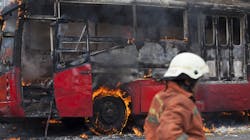OP-ED: New fire risks as a result of electric and hybrid buses
Regulation 107 – recently introduced by the United Nations Economic Commission (UNECE) – is designed to increase the safety of buses and coaches. This makes it a legal requirement for every combustion engine vehicle in the sector to be equipped with an automated fire suppression system in its engine compartment.
However, this new regulation doesn’t cover the unique fire risks associated with electric vehicles (EVs). For hybrid-electric vehicles (HEVs), the combustion engine component is covered by Regulation 107, yet the electrical components still present unaddressed risks.
EVs and HEVs are often powered by lithium-ion (li-ion) batteries, which bring about unique fire risks. However, these new risks are not considered or addressed in Regulation 107 or any other regulations implemented by the UNECE, as vehicles without combustion engines aren’t required to be equipped with any form of automated fire suppression. This means, in the event of a fire, an external system will often be needed to support effective suppression, which can increase vehicle downtime and fire spread.
UNECE’s Regulation 100 – for the construction and safety of electric powertrains – outlines a new requirement for an early warning system for failure in batteries and/or rechargeable electric energy storage systems. Automatic fire detection systems can be used to achieve this early identification, however traditional solutions will often only identify risk once temperatures have begun to rise – and at which point, for EVs and HEVs, it can be too late to suppress the risk quickly and effectively.
New fire risks
The primary risk for li-ion batteries is ‘thermal runaway’. Thermal runaway is caused by a fault in a battery’s cells, which occurs as a result of overheating, overcharging, overvoltage or physical damage to the battery. This fault can quickly lead to rapid increases in temperature, fire, toxic gas emissions and potential explosions. Once thermal runaway has started, shutting the system or vehicle down will not delay its propagation.
The most effective way to extinguish fires caused by thermal runaway is using large quantities of water, over many hours, or even days. However, this isn’t always possible – and certainly isn’t sustainable. As an effective alternative, an early fire warning system and spot cooling can prevent thermal runaway while localizing and suppressing fire.
As EVs and HEVs are introduced into public transport, these risks need to be addressed, and they require completely different risk assessments. Those risk assessments also need to consider the different locations of fire risks. For internal combustion engines (ICEs), fire sources are typically contained within the engine compartment, whereas there are often more risk areas for EVs.
Minimizing risks for EVs and HEVs
As a basis for reducing risks, operators can use a fire risk management assessment, issued by the Research Institutes of Sweden (RISE), which includes four key steps:
- Hazard identification
- Risk estimation
- Risk evaluation
- Risk reduction
When hazards are identified, they can be quantified and prioritized with any necessary actions recorded. This is called a Failure Mode and Effective Analysis, and as it prevents possible failures, it can help to increase the safety of the vehicle industry.
Those necessary actions can be recorded in an action plan, which details the risk reduction measures being taken to maximize safety. This may include:
- Risk elimination or minimization by design
- Active and passive fire-protection systems
- Improved cleaning and maintenance procedures
- Improved quality and training procedures.
About the Author

Jonas Bergström
Jonas Bergström is the business manager of bus and coach for Dafo Vehicle. He is Dafo Vehicle’s expert for all things related to the bus and coach industry and is constantly looking out for new developments to improve the safety of the industry.
